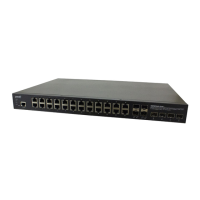Lantronix SISPM1040-xxxx-L3 Web User Guide
33856 Rev. A https://www.lantronix.com/ 232
To overcome this situation, enable aging. With aging enabled, a timer is started once the end-host gets secured.
When the timer expires, the switch starts looking for frames from the end-host, and if such frames are not seen
within the next Aging Period, the end-host is assumed to be disconnected, and the corresponding resources are
freed on the switch.
Hold Time: The hold time - measured in seconds - is used to determine how long a MAC address is held in the
MAC table if it has been found to violate the limit. The valid range is 10 - 10000000 seconds with a default of 300
seconds. The reason for holding a violating MAC address in the MAC table is primarily to ensure that the same
MAC address doesn't give rise to continuous notifications (if notifications on violation count is enabled).
Port Configuration: The table has one row for each port on the switch and several columns, which are:
Port: The port number to which the configuration below applies.
Mode: Controls whether Port Security is enabled on this port. Notice that other modules may still use the
underlying port security features without enabling Port Security on a given port.
Limit: The maximum number of MAC addresses that can be secured on this port. This number cannot exceed
1023. The default is 4. If the limit is exceeded, an action is taken corresponding to the Violation mode.
The switch is "born" with a total number of MAC addresses from which all ports draw whenever a new MAC
address is seen on a Port Security-enabled port. Since all ports draw from the same pool, it may happen that a
configured maximum cannot be granted, if the remaining ports have already used all available MAC addresses.
Violation Mode: If Limit is reached, the switch can take one of the following actions:
Protect: Do not allow more than Limit MAC addresses on the port but take no further action.
Restrict: If Limit is reached, subsequent MAC addresses on the port will be counted and marked as
violating. Such MAC addresses are removed from the MAC table when the hold time expires. At most
Violation Limit MAC addresses can be marked as violating at any given time.
Shutdown: If Limit is reached, one additional MAC address will cause the port to be shut down. This
implies that all secured MAC addresses be removed from the port, and no new addresses be learned.
There are three ways to re-open the port:
1) In the "Configuration > Ports" page's "Configured" column, first disable the port, then restore the
original mode.
2) Make a Port Security configuration change on the port.
3) Boot the switch.
Violation Limit: The maximum number of MAC addresses that can be marked as violating on this port.
This number cannot exceed 1023. The default is 4. It is only used when Violation Mode is Restrict.
State: This column shows the current Port Security state of the port. The state takes one of four values:
Disabled: Port Security is disabled on the port.
Ready: The limit is not yet reached. This can be shown for all violation modes.
Limit Reached: Indicates that the limit is reached on this port. This can be shown for all violation modes.
Shutdown: Indicates that the port is shut down by Port Security. This state can only be shown if violation
mode is set to Shutdown.
Re-open: Click the button to re-open a port that has been shut down. If a port is shut down by this module, you
may reopen it by clicking this button, which will only be enabled if this is the case. For other methods, refer to
“Shutdown” in the Action section above. Note: Clicking the Re-open button causes the page to be refreshed, so
unsaved changes will be lost.
Sticky: Enables sticky learning of MAC addresses on this port. When the port is in sticky mode, all MAC
addresses that would otherwise have been learned as dynamic are learned as sticky.
Sticky MAC addresses are part of the running-config and can therefore be saved to startup-config. Sticky MAC
addresses survive link changes (in contrast to Dynamic, which will have to be learned again). They also survive
reboots if running-config is saved to startup-config.

